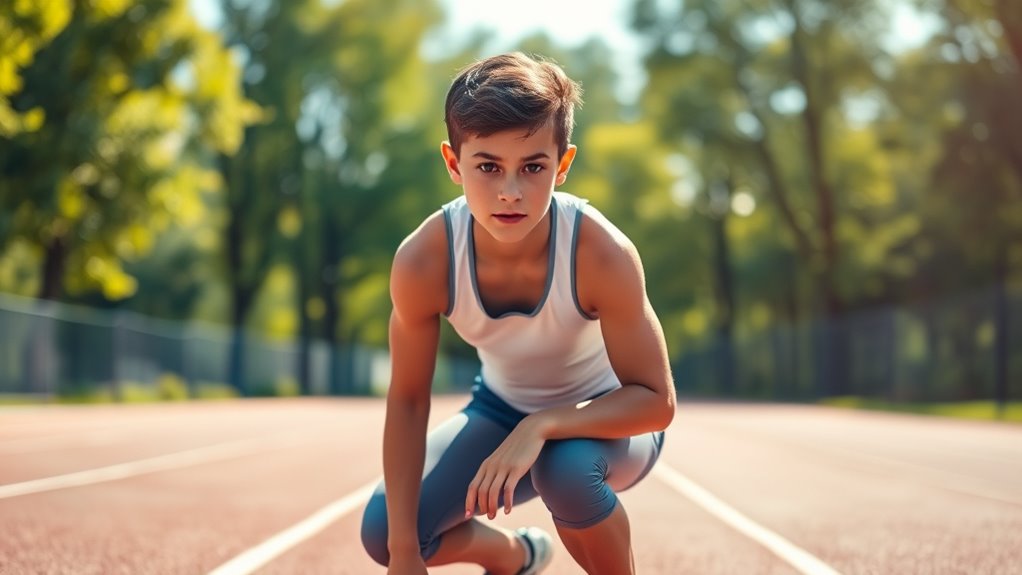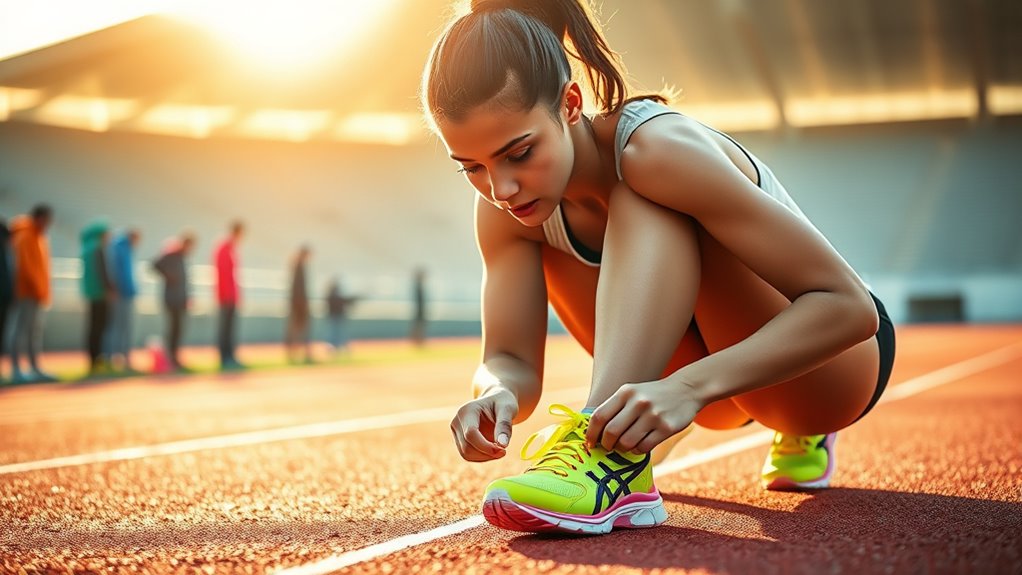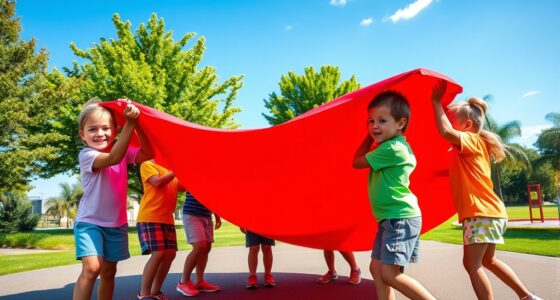To guarantee you’re truly sports ready, start training only after evaluating your current condition and avoiding high-level routines immediately after injuries or fatigue. A structured, phased approach helps you build strength and skills gradually, reducing injury risks while boosting performance. Incorporate proper warm-ups, focus on technique, and listen to your body signals. Continuing further will reveal how a tailored plan keeps you safe and enhances your long-term athletic success.
Key Takeaways
- Begin training only after recovering from injuries and when physically and mentally prepared.
- Use a phased, gradual approach to build strength, endurance, and skill safely.
- Incorporate proper warm-ups, technique, and rest to prevent injuries and optimize readiness.
- Avoid high-intensity routines immediately post-injury or during fatigue to prevent setbacks.
- Tailor training programs to individual needs, focusing on performance improvement and injury prevention.

Are you truly prepared to perform at your best in sports? The key to peak performance starts long before you step onto the field or court. One of the most important aspects of sports readiness is establishing effective training programs that suit your specific needs and goals. These programs aren’t just about improving strength, speed, or agility; they’re also designed to prepare your body for the demands of your sport and help prevent injuries. Starting the right training program at the right time is essential because it lays the foundation for success and longevity in your athletic pursuits. If you jump into intense activity without proper preparation, you risk setbacks that could sideline you for weeks or even months.
Proper training programs are crucial for injury prevention and peak athletic performance.
Timing is everything when it comes to sports readiness. You shouldn’t hop into a high-level training routine immediately after an injury or during a period of physical or mental fatigue. Instead, you need to assess your current condition and gradually build up your capacity. This means incorporating a well-structured training program that balances strength training, cardio, flexibility, and sport-specific drills. The goal is to gradually increase intensity and volume, allowing your body to adapt safely and effectively. This phased approach not only enhances your overall performance but also considerably reduces the risk of injury.
Injury prevention is a key element of any sports readiness plan. When you start training at the appropriate time, you give your muscles, tendons, and ligaments the chance to strengthen progressively. Proper warm-ups, cool-downs, and stretching routines form part of your injury prevention strategy, helping to reduce muscle strains and joint issues. Additionally, paying attention to proper technique during training and not overtraining ensures you don’t push your body beyond its limits. Recognizing early signs of fatigue or pain and responding to them by resting or modifying your workouts can prevent small issues from becoming serious injuries. Incorporating proper equipment can also play a vital role in safeguarding against injury and enhancing performance.
Knowing when to start and how to prepare can make all the difference in your athletic journey. It’s tempting to plunge into intense training sessions to see quick gains, but rushing can backfire. Prioritize a smart, phased approach with tailored training programs built around your current fitness level and goals. Doing so not only boosts your performance but also minimizes injury risks, ensuring you remain active and competitive for years to come. Remember, sports readiness isn’t just about pushing harder; it’s about training smarter, listening to your body, and preparing thoroughly so you can perform at your absolute best.
Frequently Asked Questions
How Can Parents Identify Their Child’s Sports Readiness?
You can identify your child’s sports readiness by observing their motor skill development and physical growth. If they can run, jump, and coordinate movements confidently, they’re likely ready to try sports. Watch for enthusiasm and attention span during activities. confirm they enjoy the process without feeling pressured. When their physical growth supports more complex movements, it’s a good sign they’re prepared to start, fostering confidence and enjoyment in sports.
Are There Age-Specific Indicators of Sports Readiness?
Ever wonder if your child’s age matches their sports readiness? Yes, age-specific indicators matter. For younger kids, look for early motor skills like running, jumping, and balance. For older children, social development becomes key—can they follow rules, take turns, and cooperate? These signs help you determine if they’re ready to start sports, ensuring they enjoy and benefit from physical activity at the right time.
What Role Does Mental Maturity Play in Sports Readiness?
Mental maturity plays a vital role in sports readiness by ensuring you have the mental resilience to handle setbacks and the emotional regulation to stay focused under pressure. When you’re emotionally mature, you can manage frustration, celebrate successes humbly, and maintain motivation. Developing these qualities helps you adapt to challenges, build confidence, and perform consistently, making mental maturity a key factor in determining when you’re truly ready to start sports.
How Do Socioeconomic Factors Influence Sports Initiation Timing?
Like a gatekeeper, socioeconomic factors shape when you can begin sports. You might face socioeconomic barriers, such as limited access to facilities or equipment, delaying your start. These barriers can prevent early participation, making it harder to develop skills and confidence. When resources are scarce, your initiation into sports might be postponed, affecting long-term engagement and growth. Addressing these barriers guarantees more equitable opportunities for everyone to start when they’re ready.
Can Late Starters Excel in Sports Despite Delayed Readiness?
Yes, late bloomers can excel in sports despite delayed readiness. Your focus on skill development and perseverance can lead to significant progress. Being a late starter doesn’t mean you’re at a disadvantage; it allows you to build a strong foundation without early pressure. With dedication, consistent training, and a positive mindset, you can achieve high performance and even surpass early starters in your chosen sport.
Conclusion
Now that you know when to start and why, it’s tempting to jump right in. But are you truly ready? The right moment can make all the difference—pushing your limits or risking injury. Stay alert, listen to your body, and trust your instincts. The decision is yours. Will you wait for the perfect sign, or seize the opportunity now? The choice is yours—are you prepared to take that next step?










